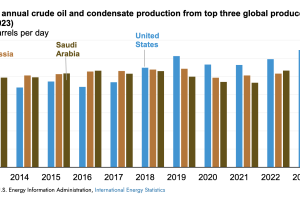The financial gears of the nation are slowing down

US banks are witnessing a shift in lending dynamics and what role the banks play in this financial landscape, and more…
U.S. banks are witnessing a shift in their lending landscape, as tighter credit standards and decreased loan demand from both businesses and consumers become evident in the second quarter, according to newly released Federal Reserve survey data. This aligns with the Federal Reserve’s intended outcome from its interest-rate increase campaign, showing that the financial gears of the nation are indeed slowing down. Looking ahead, the survey anticipates continued tightening of lending standards throughout the remainder of 2023.
With that in mind, let’s dive in and explore how banks, loans, and money are all connected!
This article takes a closer look at how changes in bank regulations can significantly impact our economic landscape.
The Role of Banks in Credit Supply
Ever wondered how banks influence our ability to borrow money and make purchases? Well, banks play a crucial role in this process! They’re like middlemen between people who save money and those who want to borrow money. Think of them as traffic controllers for money flow. When banks change their rules about who can borrow and how much, it affects our ability to get loans and buy things.
Bank-Specific Factors: Influences on Lending Standards
When banks decide whether to give out loans or tighten their lending rules, they consider a bunch of factors that help them make smart decisions about who to lend money to and how much.
Let’s break down these factors to get a clearer picture.
- Profitability: Banks want to make money, right? So, they look at how much money they’re making from their lending activities. If they’re doing well, they might be more willing to lend.
- Asset Quality: Banks want to make sure that the people they lend money to will actually pay it back. So, they check if their existing loans are going well or if they’re having trouble collecting money. If lots of loans are going bad, they might tighten up lending.
- Balance Sheet Composition: This is like a financial health check for banks. They look at how much money they have and how much they’ve lent out. If they see they’ve lent out too much compared to what they have, they might be more careful about new loans.
- Liquidity Position: Imagine you’re a bank, and you have to give back money to people who saved with you. You need to have enough cash to do that. If banks don’t have enough cash on hand, they might be cautious about giving out new loans.
- Market Indicators: Banks keep an eye on the stock market and other economic indicators. If things are looking good, they might feel more confident about lending. For example, if their own stock prices are going up, it could mean they’re doing well and can lend more.
All these factors together help banks decide how to adjust their lending rules. If they’re making money, their loans are doing well, and they have enough cash, they might lend more freely. But if things are uncertain or not looking good, they might tighten up their lending to be safer. It’s like a balancing act for banks to make sure they’re helping people while also keeping their own financial health in check.
Macroeconomic Factors: A Dual Impact on Credit
Understanding how the broader economy affects lending practices is like solving a puzzle with many pieces. There’s a fascinating interaction between big economic factors and how banks decide to give out loans. Let’s dive into this complex relationship.
- Economic Outlook: Imagine you’re running a bank and you see the economy is booming. People have jobs, companies are growing, and everything seems positive. In such times, banks might feel more confident to lend money, thinking that borrowers are likely to pay back because they have stable income. On the flip side, if the economy isn’t doing so well, banks might become cautious about lending because they’re worried people might lose their jobs and have trouble paying back loans.
- Risk Tolerance: Think of this as banks’ willingness to take chances. When the economy is doing great, banks might feel more comfortable taking risks and lending money to borrowers who might have a bit more uncertainty. But when things are uncertain or risky in the economy, banks might become more conservative and careful about who they lend to.
- Uncertainty: Just like how you might hesitate to make big decisions when things are uncertain in your life, banks also get uneasy when the economic future is unclear. If there’s a lot of uncertainty, banks might tighten their lending rules to be safe. They want to make sure they’re lending to people who are likely to pay back even if things get tough.
❗Now, here’s where it gets really interesting. These same economic factors not only affect how banks lend but also how much people want to borrow. If the economy is going strong, more people might want to borrow money to start businesses or buy houses. On the other hand, if the economy isn’t looking good, people might hold off on borrowing because they’re worried about their future finances.
So, these macroeconomic factors have a dual impact. They influence how banks lend, but they also shape how much people want to borrow. Banks and borrowers, both reacting to what’s happening in the bigger economy. This intricate relationship helps us understand why lending practices change and how they’re connected to the overall economic picture.
The macroeconomic landscape plays a significant role in shaping shifts in lending standards. While changes in economic outlook and the degree of confidence about these prospects are key drivers behind changes in lending policies, it’s important to understand that these factors play a substantial role in influencing the demand for loans.
The below are the macroeconomic indicators that provide insights into the economic outlook and current conditions:
→ Expected Year-Ahead Growth in Real GDP
→ Expected Year-Ahead Change in Unemployment Rate
→ Expected Year-Ahead Change in the 3-Month Treasury Bill Rate
→ Expected Year-Ahead Change in the 10-Year Treasury Yield
Macroeconomic Implications: Broader Consequences
Let’s zoom out to the macroeconomic level. Adverse credit supply shocks could lead to significant and lasting macroeconomic consequences.
– Reduced borrowing capacity,
– slowed economic growth,
– altered credit spreads, and
– monetary policy shifts are key outcomes.
Imagine we’re looking at a painting, but now we’re stepping back to see the whole canvas. When we do this in economics, we’re zooming out to understand how individual bank actions impact the entire economy. Let’s explore what happens when we connect the dots between banks and the big economic picture.
- Connecting Micro and Macro: We’ve been focusing on individual banks and how they adjust their lending rules. Now, we’re putting those individual bank stories into a larger context. It’s like adding each puzzle piece to the entire puzzle, so we can see the full picture. We’re not just looking at individual puzzle pieces anymore – we’re seeing how they all fit together in a framework.
- Credit Shock Ripples: Remember the puzzle piece that represented changes in the supply of bank loans? When we place that piece into our framework, we start to see how it affects everything else. It’s like dropping a stone into a calm pond – the ripples spread out and touch different parts of the water.
- Lasting Consequences: Those ripples, in economic terms, lead to some significant and lasting impacts. When banks tighten their lending, the capacity for businesses and households to borrow shrinks. This can slow down economic growth, like a car driving at a slower speed. This slowdown isn’t just temporary – it can last a while, affecting the overall size of the economy.
- Changing Spreads and Policies: Those ripples also cause other changes. Credit spreads – the difference between borrowing costs for businesses and safe government rates – can rise. This is like the cost of borrowing becoming more expensive. Additionally, the central bank might change its monetary policy, like adjusting interest rates, in response to these credit shocks. It’s like the captain adjusting the sails to navigate rough waters.
In a nutshell,
… by connecting the micro-level stories of individual banks with the macro-level canvas of the entire economy, we see that changes in lending standards have widespread effects. It’s like realizing that a small brushstroke in one corner of the painting can change the mood and tone of the entire artwork. The macroeconomic implications give us a deeper understanding of how the decisions of banks can shape the economic landscape we all live in.
* → Greedflation: presents an intriguing departure from conventional economic explanations of inflation.This concept suggests that profit-oriented businesses hold a substantial influence over the inflationary pressures experienced within economies. This novel perspective gains traction in the backdrop of current economic trends, particularly in regions like Europe and the United States.
However, the “greedflation” concept prompts us to question whether assigning inflation solely to corporate avarice paints an accurate picture or oversimplifies a complex economic reality.
TRENDING ORIGINALS
Never Miss What’s Happening In Business and Tech
Trusted By 450k+ Readers







